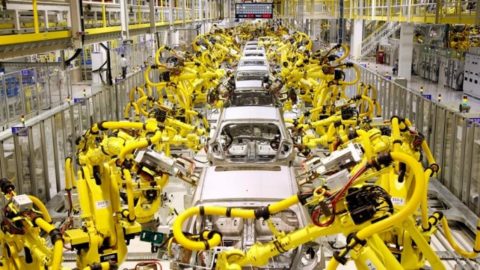
Robots are now widely used in many manufacturing industries for their ability to improve performance beyond humans. Especially in the automotive manufacturing sector, the robotic arm has become a typical symbol for manufacturing factories in this industry. Robots can replace humans to perform high-precision calibration operations such as welding, turning, drilling… or heavy, dangerous and repetitive jobs such as unloading and transporting.
Take the example of a Ford assembly line: Here, the robot units are clearly delineated behind a protective barrier and kept away from humans. Operations in assembly processes are performed completely automatically according to preset configurations or remotely controlled by humans. In addition, the optical sensor system also helps the robot to identify foreign objects within the scope of operation, thereby avoiding unnecessary errors and accidents.
In addition to the assembly process, today’s chassis machining is also heavily dependent on the robotic arm. Welding robot is programmed so it can be used to weld many different types of chassis, welds are also designed with many complex shapes to be compatible with many different types of products. We can take a look at some outstanding advantages of welding robots such as: superior speed and performance, high precision and customization, reduced waste and waste and reduced production costs. Many famous car manufacturers in the world such as Ford, GM, Mercedes, Toyota, Hyundai, Honda, and Nissan… all apply automatic welding lines on a large scale.
While performance and quality may be all you care about, if you take advantage of the other potentials of this technology, you will realize the value that robots bring to reality much more. The control system not only plays a central role for the coordinator, but is also responsible for monitoring and recording abnormal errors during the production process. Today, modern servers allow managers to continuously monitor production data in real time, thereby quickly adapting them to customer requirements.
Andreas Bauer – Head of research group Datacenter (University of Augsburg) said: “Robots can help some businesses more flexible in setting customizations in the assembly process – so in the same assembly process. car covers can be designed to both create a sporty lid and convert to a convertible form. This flexibility allows manufacturers to reach more and more customers.”
Pre-programmed applications like artificial intelligence and machine learning can also help optimize operations within a unit of time and drive much higher levels of modularization in production.
(To be continued)
Productivity and Quality Office